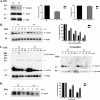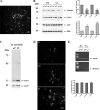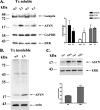Wild type alpha-synuclein is degraded by chaperone-mediated autophagy and macroautophagy in neuronal cells
- PMID: 18566453
- PMCID: PMC2527094
- DOI: 10.1074/jbc.M801992200
Wild type alpha-synuclein is degraded by chaperone-mediated autophagy and macroautophagy in neuronal cells
Abstract
Alpha-synuclein (ASYN) is crucial in Parkinson disease (PD) pathogenesis. Increased levels of wild type (WT) ASYN expression are sufficient to cause PD in humans. The manner of post-transcriptional regulation of ASYN levels is controversial. Previously, we had shown that WT ASYN can be degraded by chaperone-mediated autophagy (CMA) in isolated liver lysosomes. Whether this occurs in a cellular and, in particular, in a neuronal cell context is unclear. Using a mutant ASYN form that lacks the CMA recognition motif and RNA interference against the rate-limiting step in the CMA pathway, Lamp2a, we show here that CMA is indeed involved in WT ASYN degradation in PC12 and SH-SY5Y cells, and in primary cortical and midbrain neurons. However, the extent of involvement varies between cell types, potentially because of differences in compensatory mechanisms. CMA inhibition leads to an accumulation of soluble high molecular weight and detergent-insoluble species of ASYN, suggesting that CMA dysfunction may play a role in the generation of such aberrant species in PD. ASYN and Lamp2a are developmentally regulated in parallel in cortical neuron cultures and in vivo in the central nervous system, and they physically interact as indicated by co-immunoprecipitation. In contrast to previous reports, inhibition of macroautophagy, but not the proteasome, also leads to WT ASYN accumulation, suggesting that this lysosomal pathway is also involved in normal ASYN turnover. These results indicate that CMA and macroautophagy are important pathways for WT ASYN degradation in neurons and underline the importance of CMA as degradation machinery in the nervous system.
Figures










Similar articles
-
Abberant alpha-synuclein confers toxicity to neurons in part through inhibition of chaperone-mediated autophagy.PLoS One. 2009;4(5):e5515. doi: 10.1371/journal.pone.0005515. Epub 2009 May 13. PLoS One. 2009. PMID: 19436756 Free PMC article.
-
Age-dependent accumulation of oligomeric SNCA/α-synuclein from impaired degradation in mutant LRRK2 knockin mouse model of Parkinson disease: role for therapeutic activation of chaperone-mediated autophagy (CMA).Autophagy. 2020 Feb;16(2):347-370. doi: 10.1080/15548627.2019.1603545. Epub 2019 Apr 14. Autophagy. 2020. PMID: 30983487 Free PMC article.
-
alpha-synuclein degradation by autophagic pathways: a potential key to Parkinson's disease pathogenesis.Autophagy. 2008 Oct;4(7):917-9. doi: 10.4161/auto.6685. Epub 2008 Oct 26. Autophagy. 2008. PMID: 18708765
-
A new perspective in Parkinson's disease, chaperone-mediated autophagy.Parkinsonism Relat Disord. 2011 May;17(4):231-5. doi: 10.1016/j.parkreldis.2010.12.008. Epub 2011 Jan 7. Parkinsonism Relat Disord. 2011. PMID: 21215675 Review.
-
Autophagy and Alpha-Synuclein: Relevance to Parkinson's Disease and Related Synucleopathies.Mov Disord. 2016 Feb;31(2):178-92. doi: 10.1002/mds.26477. Epub 2016 Jan 27. Mov Disord. 2016. PMID: 26813776 Review.
Cited by
-
Cardiomyocyte ryanodine receptor degradation by chaperone-mediated autophagy.Cardiovasc Res. 2013 May 1;98(2):277-85. doi: 10.1093/cvr/cvt029. Epub 2013 Feb 11. Cardiovasc Res. 2013. PMID: 23404999 Free PMC article.
-
Sirtuins and proteolytic systems: implications for pathogenesis of synucleinopathies.Biomolecules. 2015 May 4;5(2):735-57. doi: 10.3390/biom5020735. Biomolecules. 2015. PMID: 25946078 Free PMC article. Review.
-
Alpha-Synuclein affects neurite morphology, autophagy, vesicle transport and axonal degeneration in CNS neurons.Cell Death Dis. 2015 Jul 9;6(7):e1811. doi: 10.1038/cddis.2015.169. Cell Death Dis. 2015. PMID: 26158517 Free PMC article.
-
The Proteasome Inhibition Model of Parkinson's Disease.J Parkinsons Dis. 2017;7(1):31-63. doi: 10.3233/JPD-160921. J Parkinsons Dis. 2017. PMID: 27802243 Free PMC article. Review.
-
The role of autophagy in Parkinson's disease: rotenone-based modeling.Behav Brain Funct. 2013 Mar 15;9:13. doi: 10.1186/1744-9081-9-13. Behav Brain Funct. 2013. PMID: 23497442 Free PMC article.
References
-
- Kruger, R., Kuhn, W., Muller, T., Woitalla, D., Graeber, M., Kosel, S., Przuntek, H., Epplen, J. T., Schols, L., and Riess, O. (1998) Nat. Genet. 18106 –108 - PubMed
-
- Polymeropoulos, M. H., Lavedan, C., Leroy, E., Ide, S. E., Dehejia, A., Dutra, A., Pike, B., Root, H., Rubenstein, J., Boyer, R., Stenroos, E. S., Chandrasekharappa, S., Athanassiadou, A., Papapetropoulos, T., Johnson, W. G., Lazzarini, A. M., Duvoisin, R. C., Di Iorio, G., Golbe, L. I., and Nussbaum, R. L. (1997) Science 2762045 –2047 - PubMed
-
- Singleton, A., and Gwinn-Hardy, K. (2004) Lancet 3641105 –1107 - PubMed
-
- Maraganore, D. M., de Andrade, M., Elbaz, A., Farrer, M. J., Ioannidis, J. P., Kruger, R., Rocca, W. A., Schneider, N. K., Lesnick, T. G., Lincoln, S. J., Hulihan, M. M., Aasly, J. O., Ashizawa, T., Chartier-Harlin, M. C., Checkoway, H., Ferrarese, C., Hadjigeorgiou, G., Hattori, N., Kawakami, H., Lambert, J. C., Lynch, T., Mellick, G. D., Papapetropoulos, S., Parsian, A., Quattrone, A., Riess, O., Tan, E. K., and Van Broeckhoven, C. (2006) J. Am. Med. Assoc. 296661 –670 - PubMed
-
- Bennett, M. C., Bishop, J. F., Leng, Y., Chock, P. B., Chase, T. N., and Mouradian, M. M. (1999) J. Biol. Chem. 27433855 –33858 - PubMed
Publication types
MeSH terms
Substances
Grants and funding
LinkOut - more resources
Full Text Sources
Other Literature Sources
Medical
Miscellaneous

